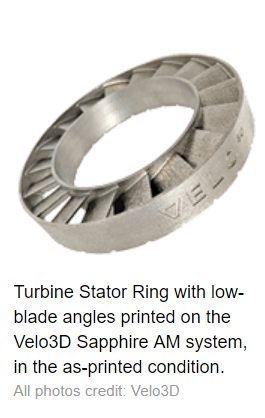Welcome to Sino Bearings web
24x7 HOTLINE:+86-28-81454188

 TECHNOLOGY
TECHNOLOGY
Shortages of aerospace replacement-part inventories, high costs, and routine production delays in sourcing cast components, combined with the pandemic’s impact on normal aircraft/supplier production, shipping, and labor, have put the industry on the ropes. Not only are new plane orders and standard inventory support experiencing problems, but aging fleets of useful, still profitable planes sit idle because of a lack of parts.
It’s the complex and changing set of circumstances that aerospace original equipment manufacturers (OEM), lessors and maintenance, repair, and overhaul (MRO) businesses currently face. Advanced additive manufacturing (AM) is about to democratize aerospace MRO across the supply chain, lowering cost for parts delivered in less time.
Challenges facing MRO
The MRO multi-source business environment includes aircraft OEMs and dedicated large and small suppliers. Most firms want bigger roles and higher margins that part replacement currently commands. The challenge is how to best solve high cost, low volumes, and crippling delivery schedules.
Replacing worn tooling for cast parts of blades, stators, housings, and other engine components is problematic. Tooling can cost tens-to-hundreds of thousands of dollars; a tedious and exacting process involving thousands of part types for costly-to-store, 20-to-50-year product cycles, or for part runs of as few as one to 10 components at a time.
Casting is a capital-intensive technology inflexible to design changes with long lead times that force high inventories to stabilize the supply chain. Commodity additive manufacturing (AM) has its own issues: calibrating machines for series production, achieving measurable quality, favorable yields, acceptable cost per part, and reasonable turnarounds through post-processing. But large MRO manufacturers using commodity AM have the resources to secure certification to make specific, limited, flight-worthy parts, sometimes costing them millions of dollars.
To catch up with demand for aerospace parts and avoid commodity AM’s shortfalls requires advanced AM systems. Forces and events are aligning to democratize AM for OEMs & MROs, small and large, and make on-demand production of parts fast, cost-effective, and almost as predictable as CNC machining.
Changes in AM process certification
The largest companies in commercial aircraft manufacturing developed internal materials allowing them to produce AM parts certified for flight. For these early adopters that spent heavily on AM characterization and testing, FAA 14 CFR 21.1 permits airframe and engine type certificate holders to serve the marketplace.
For others in the MRO field, few or no FAA-recognized specs or allowables have been available. The MRO market has encountered significant certification challenges holding back the widespread use of AM.
Access to a robust, standardized data set, MMPDS Volume 2 for Additive Materials, will enable MROs to embrace AM without going to extreme, solo efforts requiring significant time and expense. Metallic Materials Properties Development & Standardization (MMPDS) is an industry source for design allowables recognized by the FAA, DOD, and NASA. It references a material spec, typically AMS (Aerospace Material Standards), that can be used for parts and repairs.
Direct part replacement
The most pressing MRO need is producing duplicates of stator vanes, bearing housings, and other key components to keep existing planes flying. While AM is recognized for its extraordinary part-consolidation and blank-sheet design capabilities, it’s also suited for the economics of direct (exact) part replacement. While incremental increases in casting capacity can cost tens-of-millions of dollars, part production using AM can be had at a cost of $1 million-to-$2 million per machine. Plus, AM is flexible in the volumes it’s able to produce and the endless types of geometries that can be printed from each machine, in contrast to the casting process. AM can also produce the same part with better tensile material qualities and higher density than castings.
A series of AM machines can tackle full-production volumes of an identical part stream, then switch to near-on-demand inventory-fulfilment appropriate for MRO. Or they can prototype design-to-manufacture concepts for future products. This lower cost, flexible AM alternative can match up with a manufacturer’s existing cast and machining portfolio to improve supply chain dynamics. Faster, better, more agile, and less expensive.
Advanced AM performance
Both casting and conventional AM have limits. Recent AM material guidelines encourage change and likely accelerate investment in newer MRO AM solutions. Advanced AM already offers automation, quality and process monitoring, non-contact recoater blades, controlled atmospheres, and software to open up the market.
Analyzing atmosphere composition is critical to reaching aerospace quality standards. When manufacturers print metal parts in a less-than-perfect build-chamber environment at high temperatures, it can incorporate unwanted atoms or molecules in the atmosphere into the material as it solidifies. Excess oxygen in the chamber can lead to oxidation and porosity. Hydrogen can react with and embrittle the finished metal. Small amounts of humidity will ionize under the laser, potentially compromising part quality. The best AM developers have borrowed atmosphere control strategies from the microchip industry to ensure quality and design freedom.
Proper powder-bed height is critical for ensuring AM can make aerospace parts that were previously cast. During a build, it’s essential that correct powder-bed height be maintained with no ridges, waves, or variations. The powder-bed is the feedstock in the welding process and consistent feedstock is critical to quality. In commodity AM, protuberances of solid metal in the powder bed represent the most frequent problem as the blades operate as a windshield wiper. Next-generation AM systems offer a non-contact recoater arm and integrated metrology so the topology of the powder bed is constantly, quantitatively measured and monitored for inconsistencies. This is another example where AM exceeds the process controls of traditional manufacturing processes.
The options for addressing the intertwined manufacturing and economic challenges faced by aerospace OEMs and MRO part-replacement services are expanding. Frustration about slow progress in AM is no longer justified. Contract manufacturers in aerospace with advanced AM are ready to produce replacement parts at equal or better quality than cast originals as-needed, in low volumes and at lower cost.